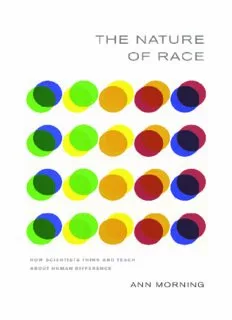
The Nature of Race: How Scientists Think and Teach about Human Difference PDF
Preview The Nature of Race: How Scientists Think and Teach about Human Difference
The Nature of Race The Nature of Race HOW SCIENTISTS THINK A ND TEACH A BOUT HUM A N DIFFERENCE A NN MOR NING university of california press Berkeley Los Angeles London University of California Press, one of the most distinguished university presses in the United States, enriches lives around the world by advancing scholarship in the humanities, social sciences, and natural sciences. Its activities are supported by the UC Press Founda- tion and by philanthropic contributions from individuals and institutions. For more information, visit www .ucpress .edu . University of California Press Berkeley and Los Angeles, California University of California Press, Ltd. London, En gland © 2011 by The Regents of the University of California Library of Congress Cataloging- in- Publication Data Morning, Ann Juanita, 1968– The nature of race : how scientists think and teach about human difference / Ann Morning. p. cm. Includes bibliographical references and index. ISBN 978- 0- 520- 27030- 5 (cloth : alk. paper) ISBN 978- 0- 520- 27031- 2 (pbk. : alk. paper) 1. Race. 2. Racism in anthropology. 3. Racism in education. 4. Racism in textbooks. I. Title. GN269.M675 2011 305.8—dc22 2011000291 Manufactured in the United States of America 20 19 18 17 16 15 14 13 12 11 10 9 8 7 6 5 4 3 2 1 This book is printed on Cascades Enviro 100, a 100% post consumer waste, recycled, de- inked fi ber. FSC recycled certifi ed and pro cessed chlorine free. It is acid free, Ecologo certifi ed, and manufactured by BioGas energy. Contents List of Illustrations vi Ac know ledg ments ix 1. Introduction: What Is Race? 1 2. What Do We Know about Scientifi c and Pop u lar Concepts of Race? 22 3. Textbook Race: Lessons on Human Difference 66 4. Teaching Race: Scientists on Human Difference 103 5. Learning Race: Students on Human Difference 142 6. Race Concepts beyond the Classroom 191 7. Conclusion: The Redemption of Essentialism 219 Appendix A. Textbook Sample Selection and List 249 Appendix B. Interview Research Design and Methodology 257 Appendix C. Faculty Questionnaire 263 Appendix D. Student Questionnaire 267 Notes 271 References 279 Index 305 Illustrations boxes 1. Defi nitions of Race by Discipline, Selected Textbooks 77 2. Selected Accounts of Racial Ancestry in World Geography Textbooks 85 tables 1. Faculty Race Concepts by Academic Discipline 111 2. Faculty Characteristics by Defi nition of Race and by Opinion of Lieberman Statement 128 3. Student Characteristics by University 146 4. Student Race Concepts by University 175 5. Student Race Concepts by Academic Major 180 6. University Undergraduate Data, AY 2001–02 259 illustrations vii figures 1. “Caucasoid, Negroid, and Mongoloid Groups,” 1995 79 2. “Latin America’s Ethnic Diversity,” 2001 84 3. Malaria and Sickle- Cell Anemia in Africa, Eu rope, and Asia, 2002 89 4. Sickle- Cell Anemia and Malaria in Africa Only, 2002 90 5. “The Races of Men,” 1952 93 6. “Five Major Human Races,” 1976 97 7. “Different Racial Groups,” 1998 98 8. Percentage of Department Faculty and Majors Defi ning Race as Socially Constructed 182 9. “Races of Man,” 1958 238 Ac knowl edg ments The people to whom I owe the most for this book are paradoxically those I know the least: the ninety-t hree individuals I interviewed and quoted extensively in the pages to follow. I probably w ouldn’t recognize—o r be recognized by—a ny of them on the street now, but their ideas and words have breathed life into mine. I am deeply grateful to these men and women for the time and experiences they shared with me. Several organizations provided support for this project. I thank the National Science Foundation (and especially John Perhonis) for a Dis- sertation Improvement Award from the program in Societal Dimensions of Engineering, Science and Technology; the Ford Foundation and Na- tional Research Council for Diversity Fellowships at both the doctoral and postdoctoral levels (and Columbia University’s Department of Soci- ology for hosting my postdoctoral year); the Spencer Foundation for a Dissertation Fellowship; and Princet on University’s Center for Arts and Cultural Policy Studies as well as its Program (now a Center) in African American Studies for research funding. I am also grateful to my former ix
Description: